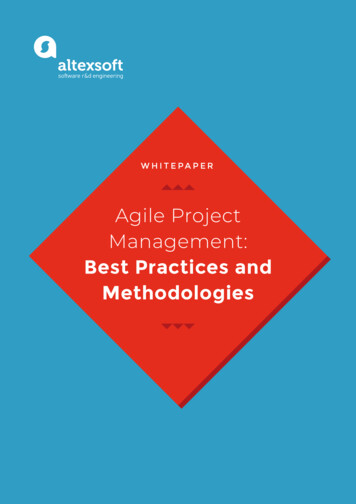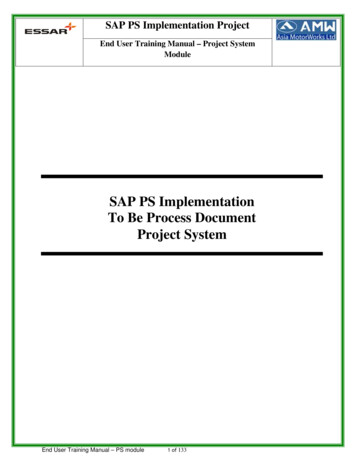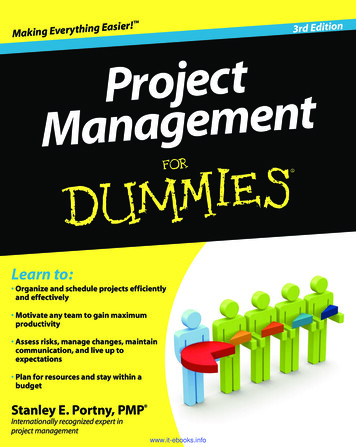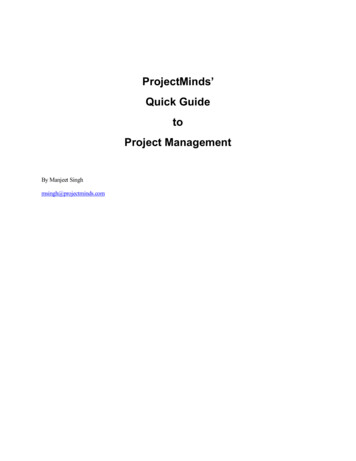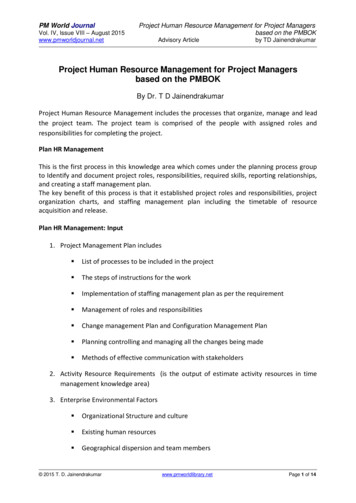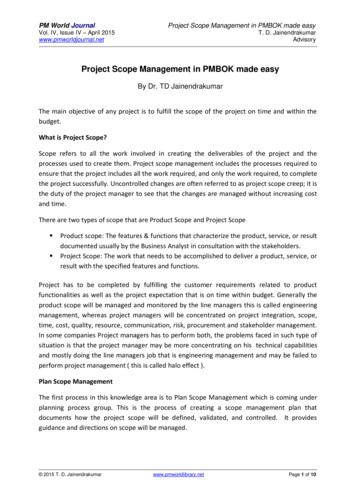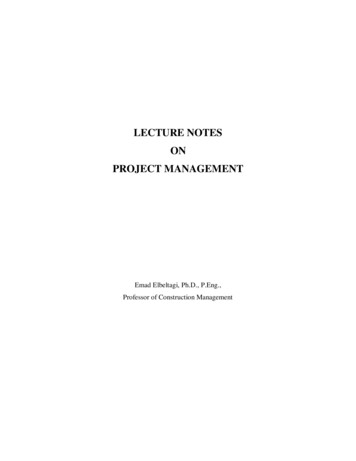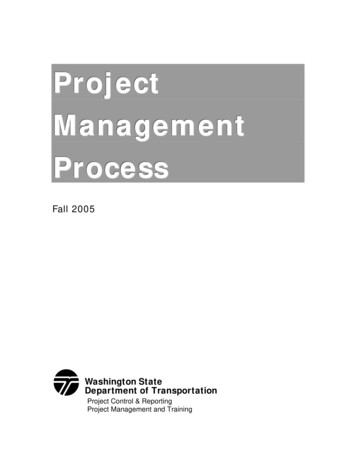
Transcription
ProjectManagementProcessFall 2005Washington StateDepartment of TransportationProject Control & ReportingProject Management and Training
WASHINGTON STATE DEPARTMENT OF TRANSPORTATIONPROJECT DEVELOPMENT TRAININGProject Management ProcessAcknowledgements:Patty Mutton, HQ Project Management & TrainingPat Forza, HQ Project Management & TrainingMark Gabel, HQ Cost Risk Estimating ManagementBlane Long, HQ DesignBill Elliott, Olympic Region
ContentsPage iiProject Management ProcessFall 2005
ContentsContents. iiiCourse Objectives. vTeamwork Exercise . viMODULE 3ENDORSE THE PLANWhat is Endorsement?.103INTR ODUCTIONWSDOT Management Principals .7Project Management .10Scope, Schedule, Budget Triangle.20Project Team Commitment .104Management Endorsement .108MODULE 4WORK THE PLANProject Management Online Guide .20Project Performance Baseline.112MODULE 1IN IT IA T E AND A LIGNManage Scope, Schedule, & Budget .118Manage Risks .124Project Description.24Change Management.128Team Mission/Assignment .28Communication and Team Building .134Major Milestones.32Communicate: Progress, Issues, and LessonsLearned.136Boundaries.36Team Identification.40Roles and Responsibilities .42Measures of Success.46Operating Guidelines .48Summary.50MODULE 5TR ANSITION AND CLOSUREReview Lessons Learned.144Reward and Recognize.146Archive .148SR 101 Purpose and Mission Exercise .52A Flock of Geese .53Teams .55MODULE 2PLAN TH E WORKA P P EN D IX AE X E C U T I VE O R D ER E 1 0 3 2 . 0 0A P P EN D IX BMASTER DELIVERABLES LISTWork Breakdown Structure (WBS).58Task Planning and Scheduling.66Budget .70Risk Planning .72A P P EN D IX CU S 101, PROJECT MANAGEMENTPLANCommunication Plan.78Change Management .86Quality (QA/QC) Plan.90A P P EN D IX DHANDOU TSTransition & Closure Plan .94Project Management ProcessFall 2005ContentsPage iii
Course ObjectivesPage ivProject Management ProcessFall 2005
Course ObjectivesCourse Title:Project Management ProcessCourse Code:B71Date:Location:Instructor(s):AFTER SUCCESSFUL COMPLETION OF THIS COURSE,STUDENTS WILL BE ABLE TO:Initiate and align a project team;Use the Master Deliverables List (MDL) to develop a project specific WBS;Develop a Project Management Plan (PMP);Assess project risk;Obtain endorsement for a Project Management Plan;Manage scope, schedule, and budget;Manage change;Conduct an effective project closure.This course provides WSDOT staff with foundational knowledge and skills in projectmanagement principles and methodologies as described inwww.wsdot.wa.gov/Projects/ProjectMgmt/ . WSDOT’s project management processesprovide the tools for interdisciplinary teams to efficiently and effectively deliver projectswithin scope, schedule and budget.References: WSDOT Project Management mt/ WSDOT Executive Order 1032.00 WSDOT Management inciples.htm A Guide to Project Management body of Knowledge, Third Edition(PMBOK), Project Management Institute (PMI) The Project Management Professional Exam textbook, 2005 Edition,Velociteach Project Management, Harold Kerzner, PhDProject Management ProcessFall 2005Course ObjectivesPage v
Teamwork ExerciseGoal: Each team is responsible for building a bridge that meets the following criteria.Schedule: 8 minutes and 47 secondsWork as a team/everyone must contributeWhat is your budget?Building materials may be purchased at the local bridge store.Meet the following requirements:Finish on time and on budgetImpress the public with your workThe bridge opening will be aired on the evening news What do they need to know?The bridge must carry 2400 vphSpan 237.25 feetSR 433, Lewis & Clark BridgeTeam ExercisePage viProject Management ProcessFall 2005
Introductionhis course identifies the principles and methodologies adopted by the WashingtonState Department of Transportation (WSDOT) for successful project managementand delivery. Project management requires the application of skills, knowledge,tools, and techniques to deliver the project on time, within budget, and according tospecifications. WSDOT’s project management process is based on proven industrystandards for project management, such as the Project Management Body of Knowledge(PMBOK) prepared by the Project Management Institute (PMI).TWSDOT Management PrincipalsOur mission is to keep people and business moving by operating and improving thestate’s transportation systems vital to our taxpayers and communities. These are ourmanagement principles:LeadershipWe are committed that WSDOT provide strategic vision and leadership for our state’stransportation needs.Delivery and AccountabilityWe shall manage the resources taxpayers and the legislature entrusted to us for thehighest possible return on value. We shall be disciplined in our use of both time andmoney. We shall account for our achievements, our shortcomings and our challenges tocitizens, to elected officials, and to other public agencies.Business PracticesWe shall encourage progressive business management practices in delivering costeffective and efficient transportation services. Our quest for short-term cost savings andbusiness process improvement shall be balanced by the long term need to preserve andimprove the state’s transportation systems through sound fiscal planning and assetmanagement.SafetyConcern for the health and safety of the people who use and work on our transportationfacilities shall be a paramount value in every area of our business.Environmental ResponsibilityOur work shall incorporate the principles of environmental protection and stewardshipinto the day-to-day operations of the department as well as the on-going development ofthe state’s transportation facilities.Project Management ProcessFall 2005IntroductionPage 7
Excellence and IntegrityOur employees shall work in a culture of workplace excellence and diversity thatencourages creativity and personal responsibility, values teamwork, and always respectsthe contributions of one another and of those with whom we do business. We shalladhere to the highest standards of courtesy, integrity and ethical conduct. We shallencourage and recognize our employees’ professionalism and their career growth.CommunicationsWe shall stress the importance of sharing clear, concise, and timely information withWSDOT employees, elected officials, community leaders, businesses, citizens andtaxpayers, others in the transportation community, with the press and other media. Weshall strive for the effectiveness of all our employees in meeting WSDOT’scommunications standards.WSDOT’s Project Management principals can be found htm)IntroductionPage 8Project Management ProcessFall 2005
Industry StandardsA set of proven tools available to help projectmanagers and teams define, execute, and deliverprojects more effectively.Plan the WorkPlanthe WorkInitiate& AlignEndorsethe PlanWork the PlanWorkthe PlanTransition& ClosehipLeadersccountabilityDelivery & AWSDOTManagementPrinciplesBusiness PracticesSafetyEnvironmental ResponsibilityExcellence and lity/mgmtprinciples.htmProject DeliveryAccountabilityWSDOTProject Management ProcessFall 2005IntroductionPage 9
Project ManagementWhile terminology may vary, the principles of project management are consistent. Aproject manager needs more than tools to succeed in delivering quality projects on timeand within budget. Project managers with the knowledge and skill to lead a team toward acommon goal will optimize team member talents to the best benefit of the team.The Project Management Body of Knowledge (PMBOK) describes the work planningprocess as defining and refining objectives and selecting the best alternative courses ofaction. There are many tools and techniques unique to project management; such as workbreakdown structures, critical path, or earned value. These tools and techniques alone arenot sufficient without effective project management knowledge and skills. The projectteam must recognize and use knowledge and skills from at least five areas of expertise:The Project Management Body of Knowledge - knowledge unique to the projectmanagement field and overlaps other management disciplines.Application area knowledge, standards, and regulations - Project categories withcommon elements but not necessary in all projects Functional and supporting disciplines - legal, inventory management, personnel,traffic, right-of-way, environmental, etc. Technical elements – software development or ENGINEERING Management specializations – government contracting, new product development Industry groups – automotive, chemical, agriculture.Each of these areas typically have there own set of accepted standards and practices.Understanding the project environment – the team needs to understand the positiveand/or negative cultural, political, social and environmental impacts the project may haveand how people (customers, stakeholders, etc.) may affect the project.General management knowledge and skills – planning, organizing, staffing, controllingongoing operations; including strategic planning, accounting, procurement, humanresources, information technology, etc.Interpersonal skills – effective communication, getting things done, leadership,motivation, conflict management, and problem solving.Each of these areas may appear to be discrete elements, but they generally overlap. It isnot required that every team member be an expert in all five areas, the combinedknowledge of the team leads to an effectively managed project.IntroductionPage 10Project Management ProcessFall 2005
Project Management Tools Techniques Knowledge SkillsAreas ofExpertisePlan the WorkProject ManagementBody of KnowledgeApplication AreaKnowledge,Standards, owledge &SkillsUnderstandingthe ProjectEnvironmentPMBOK, Third EditionProject Management ProcessFall 2005IntroductionPage 11
History of Project Management at WSDOTIn late 1998, a focus team was formed to begin looking at how WSDOT could moreeffectively and efficiently deliver projects. The team developed guidance and tools forproject management as it applies to WSDOT. An Instructional Letter (IL) recommendingthe use of these principles was signed in the summer of 2000, followed by DesignManual Chapter 140. The first Managing Project Delivery (MPD) class was delivered inDecember 2000. Many other tools for delivery, accountability, and communicating havefollowed: Cost Estimating & Validation Process (CEVP) Project Delivery Information System Cost Risk Assessment Project Control & Reporting (change management)JLARC ReviewThe Joint Legislative Audit and Review Committee (JLARC) review focused on theagencies critical path management, risk management, project reporting, andorganizational structures used to execute capital projects. Since the study was intended tobe a pre-audit review, only eight example projects were selected to represent the diversityof issues and characteristics in WSDOT’s capital program. JLARC chose projects wellinto the construction phase; many of these projects were designed prior to some of thetools and processes we have in place today.The Overview of Washington State Department of Transportation Capital ProjectManagement Report, January 21, 2005, made four summary managementrecommendations:Recommendation 1 – WSDOT should extend the application of the ManagingProject Delivery, Project Delivery Information System, and Primavera ProjectPlanner for the Enterprise tools and put management steps in place to confirmtheir adoption.Recommendation 2 - WSDOT should develop a plan and timeline forimplementing recommendations issued by Gannett Fleming, which centerprimarily on a) using existing exemplary practices in place at some projects todevelop minimum standards and/or templates; b) improving the clarity of projectcommunication by documenting terms and definitions; and c) confirming theconsistency and currency of reporting information.Recommendation 3 - WSDOT should conduct an assessment of the effectivenessof current information systems and options for addressing any deficiencies.Recommendation 4 - WSDOT should develop criteria for extending Cost RiskEstimating and Management (CREM) analyses to a wider universe of projects.IntroductionPage 12Project Management ProcessFall 2005
Project Management Implementationand Training edCEVP PDISgoesLive2004FormalizedProjectControl ro to ProjectScheduling &PS8Intro ingPDIS forSpecialtyGroupsJLARC Review(Joint Legislative Audit & Review Committee)Management Recommendations1. Extend the application of MPD, PDIS, & P3e2. Develop a work plan & schedule forimplementing Gannett Flemingrecommendations.3. Assess current information systems4. Cost Risk Estimating & Management t Management ProcessFall 2005IntroductionPage 13
This is followed by twenty-three key recommendations by Gannett Fleming. The reportalso includes options for future WSDOT Audit/Study topics.Audit/Study Topic 1 – Audit the effectiveness of MPD and PDIS in improving projectdelivery. Objective: To determine how new standardized schedule tools are enablingproject teams to manage schedules and the critical path. Timeline: Nine audit months(recommend delaying start date to allow full implementation of management efforts)The full report can be found on the WSDOT project management T’s ResponseWSDOT is proactively identifying ways to address these recommendations. One step wasthe formation of a Project Management Task Force. The Project Management Task Forceis made up of representatives from across the state; representing multiple disciplines(design, construction, etc.) They were tasked with identifying ways to implement theJLARC recommendations, but more importantly to improve our project managementprocess. Make the process more scalable; identify and develop easy to use tools,templates, and techniques to encourage and simplify the use of the process. The result ofthis effort is the Project Management Online Guide and Executive Order 1032.00. Copiesof the Executive Order are in Appendix A of this course workbook and available on theproject management website (www.wsdot.wa.gov/Projects/ProjectMgmt/)Project Management Process OverviewA few changes have occurred over the years but the philosophy remains the same.WSDOT’s project management process features a 5-step process very similar to otherproject management approaches being used around the world by project managers in theprivate and public sectors. The five project management steps are: Initiate & Align Plan the Work Endorse the Plan Work the Plan Transition and ClosureIntroductionPage 14Project Management ProcessFall 2005
Project Management Task Force Region & HQ Representation Improve our Project ManagementProcess Make it more scalable Provide tools & templatesResult:Project Management Online GuideExecutive OrderWhat’s it say?By this executive order all phases of WashingtonState Department of Transportation capitaltransportation projects are to be deliveredconsistent with the principles and practices ofour project management process as t(Available July 1, 2005)Project Management ProcessPlanthe WorkInitiate& Align ProjectDescription Team Mission/Assignment Major Milestones Boundaries TeamIdentification Roles &Responsibilities Measures ofSuccess OperatingGuidelines Work BreakdownStructure (WBS) /MasterDeliverables List(MDL) Task Planning &Scheduling Budget Risk Planning CommunicationPlan ChangeManagement Plan Quality (QA/QC)Plan Transition &Closure PlanEndorsethe Plan Project Team Commitment Management EndorsementWorkthe PlanTransition& Closure Managing Scope,Schedule & Budget Manage Risks Manage Change Communicate Progress Issues LessonsLearned ImplementTransition Plan Review LessonsLearned Reward &Recognize ArchiveContinuous CommunicationProject Management ProcessFall 2005IntroductionPage 15
WSDOT Project Management Process MatrixWSDOT’s project management process provides the tools to actively manage and deliverprojects. How the tools are used is up to the project manager and team. A responsibilitymatrix was developed to help you understand the process and what it might mean to you.It identifies: Who is responsible for each step Who is involved in the process What is it What are the project management steps What it looks like to team members Outcome or work productThe project manager is responsible for assuring total team participation, includingspecialty groups.A project team consists of the project manager, team members from their project office,team members from specialty groups such as Real Estate Services, Environmental,Hydraulics, Traffic, Operations, Geotech, Bridge, Utilities, and any others that are neededto deliver the project.TheisLarge and in Charge!The project manager is ultimately responsible for the outcome of the project. The projectmanager is: Formally empowered to use organizational resources In control of the project Authorized to spend the projects budget Authorized to make decisions for the projectIntroductionPage 16Project Management ProcessFall 2005
Insert full page PM matrixProject Management ProcessFall 2005IntroductionPage 17
Additional project management terms:Project - A temporary endeavor undertaken to create a unique product, service, or result.Project Management Plan – A formal, approved document used to guide both projectexecution and project control. The primary uses of the project plan are to documentplanning assumptions and decision, facilitate communication among stakeholders, anddocument approved scope, cost, and schedule baselines. A project plan may be summaryor detailed.Level vs. EffortThe five project management process steps can be further simplified into two basicphases; Plan the Work and Work the Plan.Plan the WorkInitiate& AlignPlanthe WorkWork the PlanEndorsethe PlanWorkthe PlanTransition& ClosureIn a typical project application planning the work (the first two steps) will constituteapproximately 10% of the total project effort and time. The remaining three stepsconstitute approximately 90% of the project effort and time.The graphic “Level of Effort vs. Time” provides a general sense of the relative effort andtime required for each phase during project delivery. You can see the majority of timeand effort is spent doing the work (Work the Plan).How much time, money, and effort should I spend on this project management stuff? Theamount of time spent on each of the steps should be commensurate with the followingelements: Project Size & Complexity Team Size Stakeholder Involvement Potential resistance to the projectScalability is the level of work planning required based on those elements. The ProjectManager determines the appropriate level of detail.IntroductionPage 18Project Management ProcessFall 2005
Project Management ProcessFall 2005IntroductionPage 19
Scope, Schedule, Budget TriangleAnother fundamental topic in project management is commonly referred to as “Trade-OffTriangle” or Scope, Schedule, Budget Triangle. While changes occur on a project they donot occur in a vacuum. When the scope of a project is changed, time and cost areaffected. Of course, the same is true when changes are made to cost or time.Scope, Schedule, and Budget are each project constraints and must be actively monitoredand managed throughout the project delivery process. As change occurs it is essential inproject management to be mindful of these constraints and help keep others aware of it.Changes should not always be accepted as valid; rather they should be evaluated on howthe change affects other aspects of the project.Project Management Online GuideThink of the Project Management Online Guide as many instructional manuals in oneeasy to find location. These “manuals” are based on project phase, Pre-Construction andConstruction. The five process steps remain the same regardless of phase. Within eachstep, the process elements or activity guides will vary by phase. Much as the work issubstantially different between Design and Construction.Each Activity Guide provides a description of the element, inputs, tools, steps, andproducts. There are many tools and templates available that are easily downloaded. Aglossary of project management terminology is also available.Check out the PM Online guide at: www.wsdot.wa.gov/Projects/ProjectMgmt/But first! Before diving into “doing the work” the team needs to getready and establish its direction by Initiating and Aligning theteam.IntroductionPage 20Project Management ProcessFall 2005
Project Management ProcessFall 2005IntroductionPage 21
Initiate and AlignPage 22Project Management ProcessFall 2005
1ModuleInitiate and AlignLadies and Gentlemen Start your engines!Initiate and Align is the first step of the project management process. It provides forteam building early in the process and sets the direction of the project. Effective teamsdevelop a project purpose, team mission, operating guidelines, project boundaries, roles& responsibilities, and measures of success. These elements establish a firm foundationwith a common goal in sight.: The process of formally recognizing that a new project exists(this includes transition of projects from one phase to another (i.e. Scoping to Design).“Defining Successful Performance”Region/Organization Management initiates the project by providing: Project Description; Team Mission/Assignments; Major Milestones; Boundaries.The project team reviews and commits to meeting these initial elements.: The basis for establishing a common understanding of theteam’s roles and responsibilities; the requirements of and limits on their performance; andtheir commitment to act as a cohesive and cooperative team for the effective delivery ofthe Pre-Construction Phase of the project.“Establishing team understanding and commitment to successful performance”The project manager aligns the project team by developing: Team Member Identification; Team Roles and Responsibilities; Measures of Success; Operating Guidelines.Project Management ProcessFall 2005Initiate and AlignPage 23
Project DescriptionThe Project Description is a formal statement that defines the purpose and need for the“product” or “outcome” that the project is intended to produce. Region/OrganizationManagement provides the Project Description (for example, as defined on the WSDOTProject Definition form) to the Project Manager. It is used to establish a commonpurpose and need of both the project and the project phase among the members of theproject team.TOOLSINPUTProjectDefinitionInitiate & riptionSample Initiate& AlignWorksheetsSteps for development/review of the Project Description:1. The Project Manager receives the Project Description from Region/OrganizationManagement and:Reviews the needs the project is intended to fill;Reviews the goals, products, and outcomes of the project.2. The Project Manager uses his/her understanding of the Project Description tobegin to identify team members.3. The Project Manager reviews the Project Description and preliminary teammembership with Region/Organizational Management.4. The Project Manager or designee enters the Project Description of the Initiate andAlign Worksheet.The Project Description is a statement of the reasons why the project or phase is beingundertaken, and acts as the foundation for all further project planning and actions.A Project Description generally includes the following characteristics:It is a statement of the desired condition at the end of the project; hence, itdescribes an “end result” and should be capable of being seen.It is a “project” objective, not the duty of an individual.It establishes a common goal toward which all project activities and efforts strive.It is expressed in positive terms; it is a positive end result.Initiate and AlignPage 24Project Management ProcessFall 2005
INITIATE & ALIGNProject Description Steps1. Review needs, goals, products & outcomes2. Identify team members3. Review with Region/OrganizationalManagement4. Begin Initiate & Align WorksheetINITIATE & ALIGNInitiate the ProjectRegion or Organizational Management Project Description Team Mission/Assignment Major Milestones BoundariesINITIATE & ALIGNProject Description CharacteristicsEnd result, capable of being seen“Project” objectiveCommon GoalPositive termsProject Management ProcessFall 2005Initiate and AlignPage 25
Pragmatic Benefits of a Project DescriptionRecall the adage “go slow to go fast”. Take time to establish a firm foundation for theteam. The initiation and alignment phase provides a structured way to do this - the nononsense benefits of a clear purpose are undeniable. A few of these are listed below.Work planningProvides an integrated theme for developing a written plan (i.e. writing a scope ofwork, preparing a schedule, identifying resources, developing a budget, etc.).OrganizingArranging activities into a coherent whole, making day-to-day decisions for thelong-term goal of the project.Employee DevelopmentHelps answer questions like: What skills do we need? When do we need thepeople with those skills?LeadershipEmployees want to know:“where are we going?”“how do we plan to get there?”“what role am I expected to play?”“how will my job change?”Project teams throughout history had focus or a “purpose”. Whether exploring newcontinents, building pyramids, the great wall, Panama Canal or challenging the elementsthere was a mental picture of what was to be achieved. Maybe they used a formalprocess, maybe not, but the teams knew exactly what their objectives were.Initiate and AlignPage 26Project Management ProcessFall 2005
INITIATE & ALIGNProject Description BenefitsWork Planning and OrganizationINITIATE & ALIGNProject Description BenefitsEmployee DevelopmentINITIATE & ALIGNProject Description BenefitsLeadershipProject Management ProcessFall 2005Initiate and AlignPage 27
Team Mission/AssignmentThe Team Mission Statement/Assignment is an expansion of the Project Descriptionand describes the overall actions the project team will take to accomplish its portion ofthe project. It is usually a short paragraph developed with input fromRegion/Organization Management.TOOLSINPUTProjectDefinitionInitiate & AlignWorksheetTemplateSample Initiate& AlignWorksheetsPRODUCTSCompletedTeam Mission/ AssignmentSteps for development/review of the Team Mission/Assignment:1. The Project Manager reviews the Project Description to determine the majorelements of the work needed to produce the end product or outcome of the PreConstruction Phase of the project.2. The Project Manager and the project team collaboratively develop simpledescriptions of the major activities the team will perform to produce the endproduct or outcome (e.g., develop the plans, specifications, and contractdocuments needed to advertise for bids; identify and obtain all requiredenvironmental permits).3. Review the Team Mission/Assignment Statement with the key members of theproject team in order to obtain their agreement.4. Review the Team Mission/Assignment Statement with the Region/OrganizationManagement.While the Project Description identifies the end product or outcome, the MissionStatement addresses the specific work the team is assigned to perform and relates only tospecific work deliverables and tasks needed to accomplish the assigned scope of work.The team mission is of particular importance during project work planning as it clearlydefines the scope of the Work Breakdown Structure (WBS).Initiate and AlignPage 28Project Management ProcessFall 2005
INITIATE & ALIGNTeam Mission / AssignmentAn expansion of the Project Description anddescribes the overall actions the project team willtake to accomplish its portion of the projectINITIATE & ALIGNTeam Mission / Assignment Steps1. Revie
and delivery. Project management requires the application of skills, knowledge, tools, and techniques to deliver the project on time, within budget, and according to specifications. WSDOT’s project management process is based on proven industry standards for project man



